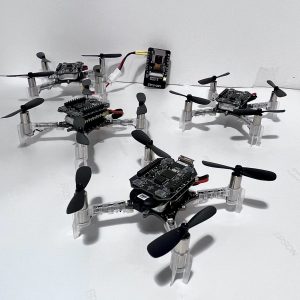
Victor Xia
Victor Wuyue Xia (夏五岳) is currently a Master of Science graduate student at Duke University MEMS Department. His research interests in the areas of aerial robotics, distributed systems, and autonomous medical devices.
Before joining Duke, he studied aerospace engineering at University of Washington, William E. Boeing Department of Aeronautics & Astronautics. At where he gained technical experiences in aerial & space vehicle design, leadership & management skills, and developed strong interest in vehicle autonomy.
Outside of work, he practices archery, kendo, and plays the bass. His favorite game is Kerbal Space Program. And he is also learning the language of French!
Say hi to him at victor.w.x@duke.edu!
His Work
Current Projects

A robot bartender!
UR5e robot arm combined with computer vision works in lab settings to explore possibilities of future autonomous drink service. Read more
A project conducted at Duke University, MEMS Department.
Previous Projects
 A long-range fixed-wing unmanned aerial vehicle that serves at the first minute of large scale natural disasters, providing cell services, air quality analysis, long-range searching capabilities and large-scale situation awareness.
A long-range fixed-wing unmanned aerial vehicle that serves at the first minute of large scale natural disasters, providing cell services, air quality analysis, long-range searching capabilities and large-scale situation awareness.
This is an undergraduate capstone project pitched and sponsored by Boeing Company, conducted at University of Washington, William E. Boeing Department of Aeronautics & Astronautics, in COVID-19 impacted working conditions.
The team designed this vehicle, analyzed its performance, and delivered to customers for evaluation. The work was done with Covid-19 impact. Below is a brief overview of this project.
The flight envelope:

The computational aerodynamical analysis and finite element structural analysis:


The mathematical model of the aircraft and the stability analysis:


The payload weight distribution:

The actuation system design:



The manufacturing plan:



This is an conceptual design project pitched by NASA, conducted at University of Washington, William E. Boeing Department of Aeronautics & Astronautics, in COVID-19 impacted working conditions.
The goal is to design a manned Ceres expedition mission that send at least 4 astronauts to Ceres and bring them back by the year of 2045. And in doing so gain project management and leadership experience. Victor Xia served as chief engineer and worked with a team of 14 members during this project.
Though only limited in concepts, this project covers wide range of aspect including orbit planning, propulsion system, energy system, life-sustaining system, manufacturing process, budget plans, etc. It was a challenge to the team’s ability to coordinate various information, as well as collaborate with members of different backgrounds working based on different principles of studies.
An example of manufacturing plans:



A camera-based system that uses stars to navigate satellite and assess its attitude.
This is a project conducted at University of Washington, William E. Boeing Department of Aeronautics & Astronautics, in COVID-19 impacted working conditions. It’s designed tailor-fit for UW’s CubeSat project, though it can be deployed on many existing and future satellites.
CubeSat is a class of micro satellites at low-earth-orbit with various types of missions. Their operations often involves collaborations among educational institutions, NASA, UN and various international organizations.
Mission concepts:

Experiment hardware:


Extracting star position & patterns from a photo:


Developing an algorithm to identify individual stars based on their surrounding patterns:

Assessing algorithm’s performance for different star map entropy:

A star map of the visible stars of the entire sky:

Assessing time complexity of the algorithm (for real-time operation):


Implementation and physical experiment result:

A 2 stage rocket engine system, including RCS thrusters, to send a hypothetical payload to Ceres.
This is an educational project conducted at University of Washington, William E. Boeing Department of Aeronautics & Astronautics, in COVID-19 impacted working conditions.
Orbital mission planning to estimate deltaV requirement for the mission:

Picking the optimum launch date (minimize fuel requirement):

Engine system diagram:

Assessing impact of hydrogen engine LH2/LOX fuel mixing-ratio, and engine nozzle expansion ratio, to vacuum specific impulse (similar to fuel efficiency):




